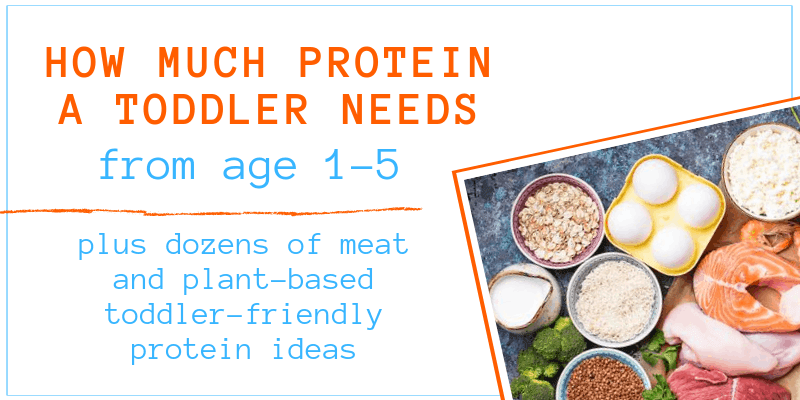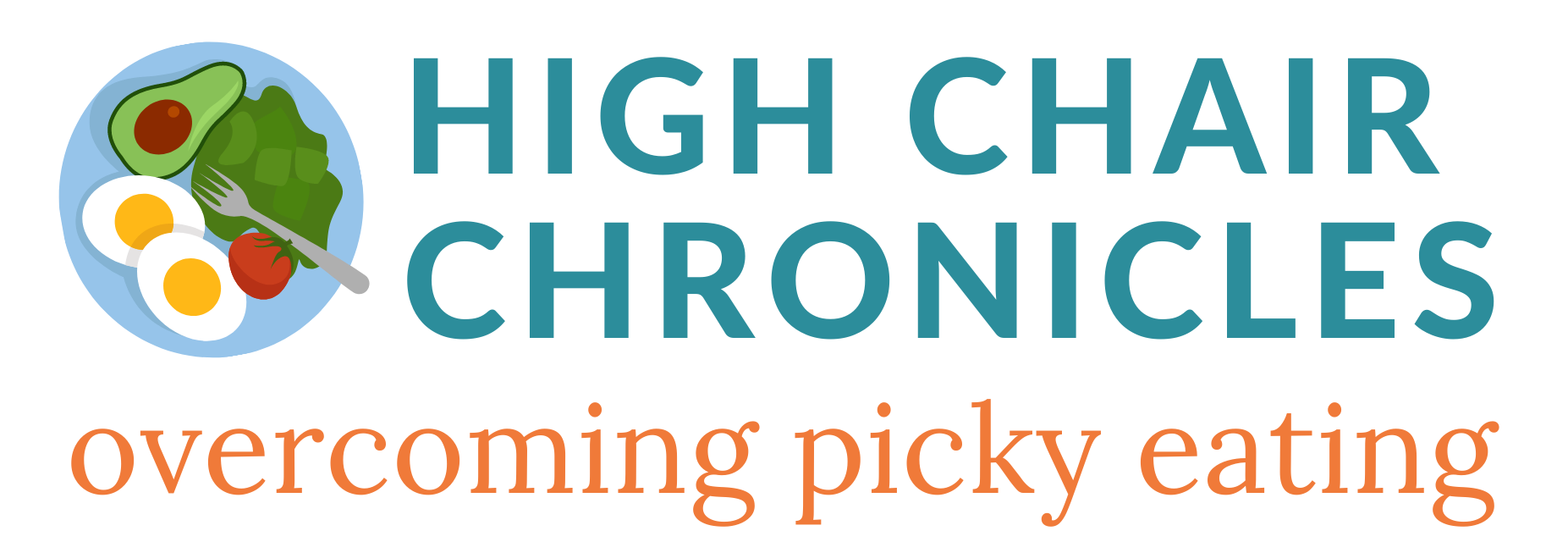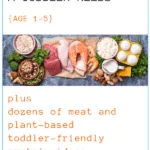A lot of parents worry about whether their toddler is getting enough protein, especially if they are a picky eater. The good news is: toddlers don't need that much protein and it's not that hard to reach their daily protein goals. This article will walk you through the amount of protein an average toddler needs from age 1 - 5, and give you ideas for toddler-friendly protein-rich foods.

I am in a few Facebook groups for parents of picky eaters (because hello, I have a picky eater toddler) and the question I see come up the most often is "Help! My kid hates meat, what can I feed him?" Parents (though let's be honest, mostly moms) are concerned that their child is not getting enough protein if they don't eat meat.
Well, luckily, toddlers don't need all that much protein. It is pretty easy to meet their recommended amount of protein in a day, even if you have a picky toddler who doesn't eat a lot of food overall.
Before I get into how much protein a toddler should eat, I wanted to mention three quick things:
- Don't worry too much about how your child eats in one specific day, but zoom out and look at the big picture: what does their diet look like over the average week? Some days they'll eat more, some days less. Some days they'll eat more fruit (see this list of lower-sugar fruits), some days they won't touch fruit. Some days they'll get enough protein, some days they won't. That's OK. As long as during the average week you are trying to feed your kid a wide variety of food, you are on the right track.
- Always check with your pediatrician or a dietitian about any advice you read online and how it pertains to YOUR child and YOUR CHILD's health and growth needs. This blog and other websites are great for learning, information, and conversation-starting ideas but at the end of the day you need to follow a professional's advice.
- I am not a professional nutritionist or dietitian. I do, however, have a strong interest in nutrition and a pretty good understanding of what a "healthy" diet looks like. I am a mom trying to figure it all out for our son, and I do my best to get all my information from current, reputable sources that I link to, so you can read for yourself. But don't hold me accountable. (See #2)
How much protein does a toddler need?
The amount of protein a toddler needs depends overall on the total amount of calories they need to take in based on their age, size, weight, and activity level. I know, this is so vague and does not help one bit. The point is, it is a little different for everyone, and there is no one-size-fits-all protein recommendation.
The average 1-3 year old needs about 0.55 grams of protein for every pound of body weight. (Source) Children ages 4-5 years old need about .45 grams of protein for every pound of body weight. This adds up to roughly 12-20 grams of protein per day, assuming the average 1 year old weighs 22 lbs, and the average 5 year old weighs 40 lbs. (Source 1, Source 2)
Keep reading or use these shortcut links to see how much protein a 1 year old, 2 year old, 3 year old, 4 year old, and 5 year old needs. I also share a list of meatless protein-rich food sources and a list of meat-based foods that you might not have thought to try already. (Clicking these links will take you directly to that section).
RELATED: Iron-Rich Foods for Toddlers
Why kids need protein:
Kids need protein to "form muscle, produce hormones, strengthen skin and bones, and transport nutrients." Foods rich in protein also contain lots of important vitamins and minerals, which are needed for a healthy diet. (Source 1, 2, 3)
But too much protein can actually be a bad thing for kids (and all people in general). Extra protein is converted to fat that can lead to kids being overweight, and can put a strain on the kidneys.
How much protein does a 1 year old need?
So let's say the average 1 year old weighs 22 lbs. At 0.55 grams protein per body weight, they need about 12 grams of protein per day. If they are drinking cow's milk or soy milk, each 8 oz bottle is about 8 grams of protein. (Source 1, 2) A bottle in the morning and at bedtime is already more protein than they need.
If your 1 year old is still drinking breast milk, you might want to supplement your baby's protein intake with foods. Breast milk has less protein than cow's milk or soy milk - about 2.5 g per 8 ounces (Source). Just be sure to offer foods that (1) your child is not allergic to and (2) your child is able to chew and eat safely. (Sooo, no steak yet!) You can make homemade baby food and add protein sources such as milk, yogurt, pea protein, or chickpeas. You can give your baby yogurt (soy or cow's milk based). You can give your baby eggs, shredded cheese, beans, crackers with thin layers of nut butter.
How much protein does a 2 year old need?
Toddlers only gain an average of 5 pounds between 1-2 years old, so a two year old's protein needs are not that much different than a 1 year old's. The good news is that most kids are able to chew better and to safely eat a wider variety of foods by the time they're two. The bad news is that most two year olds are generally a lot pickier than 1 year olds when it comes to food.
The average two year old weighs roughly 27 lbs, which means they need about 15 grams of protein per day. Again, this can be achieved just by drinking 2 cups of milk per day (cow's or soy).
If your kid is on a milk strike, you can easily get to 15 grams by offering your kid:
- 1 egg: 6 grams protein
- 2 chicken nuggets: 5 grams protein
- ¼ cup Greek yogurt (with fruit, honey, or maple syrup): 5 grams
How much protein does a 3 year old need?
The average three year old, weighing an average of 29 pounds, needs an average of 16 grams of protein per day. (Lots of averaging here, lol). This is about the same amount of protein that a two year old needs.
A few food ideas to get 16 grams of protein per day are:
- 1 inch cube of cheddar cheese (thinly sliced or shredded): 4 grams protein
- ¼ cup chickpeas: 3.6 grams protein (try them roasted, whole, mashed, or make hummus)
- and ½ cup cottage cheese: 9 grams protein (if your kid is picky about the texture of the curds, blend cottage cheese with fruit or a bit of honey, such as this whipped cottage cheese recipe)
(Source)
Protein-rich kid-friendly dinner idea: Ground Pork Meatballs with Hidden Veggies
How much protein does a 4 year old need?
Children age 4 and up need about 0.45 grams of protein for every pound of body weight. For an average 35 pound 4 year old, that's about 16 grams of protein (as much as a 3 year old).
Some other ideas for how to reach 16 grams of toddler-friendly protein per day:
- 1 oz salmon: 6 grams protein
- 1 string cheese: 8 grams protein
- ½ cup milk: 4 grams protein
How much protein does a 5 year old need?
The average 5 year old, weighing about 40 pounds, needs about 18 grams of protein per day.
Try these protein-rich foods for your 5 year old:
- ½ serving Chickapea pasta: 13 grams protein
- 2 fish sticks: 5 grams protein
Protein sources for toddlers who won't eat meat
If your toddler won't eat meat, whether for flavor or texture reasons, there are lots of other ways for them to get enough protein. Here are some ideas for non-meat protein-rich foods:
- milk (if your child won't drink milk, try blending it into a smoothie, or making mac n cheese sauce)
- soy milk (you can try a smoothie, or frozen popsicles of soy milk blended with fruit and honey or agave syrup if your child is younger than one)
- yogurt (from cow's milk or soy milk, Greek yogurt is especially high in protein. Just watch out for "kid's yogurts" and flavored yogurts that can have a ton of sugar. Add your own sugar or blend yogurt with fruit at home for a healthier option.)
- cottage cheese (blend it smooth (recipe here: whipped cottage cheese) if they are picky about texture)
- paneer (Indian cottage cheese that is firm, similar to tofu but much tastier! You can fry it in a skillet, with or without seasoning.)
- cheese (shredded, thinly sliced, melted on pizza, in mac n cheese, on a flatbread, between tortillas, or in a grilled cheese sandwich with whole wheat bread for extra protein. Try different cheeses, too, to get your child exposed to different flavors!)
- nuts (these are a choking hazard and potentially an allergy hazard, so only for older kids, or blend them into a smoothie. Also, read about food allergies in babies.)
- nut butters (a thin layer, since these are also a choking hazard, or blend them into a smoothie)
- eggs (scrambled, boiled (whole or sliced thin for a sandwich), added to pancakes or baked goods)
- quinoa (try it alone as a side dish, under marinara sauce, making veggie burgers with quinoa or little quinoa nuggets)
- amaranth (another "seed-like" grain like quinoa, but much smaller)
- whole grains (pasta, breads, muffins, pancakes)
- tofu (firm tofu can be pan-fried and tossed or dipped into their favorite sauce. Or try silk tofu, which can be blended into a smoothie or even into their milk)
- pasta made from chickpeas or lentils (such as chickapea or banza. Chickapea even makes mac n cheese!)
- beans, chickpeas, peas, and lentils (on their own, blended into hummus, or cooked in a quesadilla)
- pea protein powder (add to homemade baby food and smoothies)
You see? So many options. It just takes a few bites and it all adds up. Make sure you always offer your kid these new foods to try, even if you think they won't be into them.
And remember to get creative.
If you think your kid doesn't like quinoa because of that one time you gave it to them as a side dish, try again, but serve it covered with a sauce they like, or baked into quinoa-sweet potato nuggets (such as the ones I mention in my hidden vegetable recipes for toddlers post), or made into quinoa & black bean burgers.
If your kid doesn't like chickpeas, try pasta made from chickpeas. Or make them a smoothie with Greek yogurt and a teaspoon of pea protein powder and call it a day.
And don't forget that there are many surprising sources of protein. A half a cup of cooked brown rice has 2.5 grams of protein. A half a cup of cooked buckwheat has 3 grams of protein. A piece of whole wheat bread has 3.5 grams of protein. It all adds up.
Protein rich meat sources to try
Here are a few meat or fish based protein ideas for your kid. I know, I know, they're still meat. Your kid doesn't eat meat. But if you've mostly been trying "typical" protein sources such as chicken breast, pork chops, or meatloaf, it's worth looking through this list to see if you can try any of these with your kid:
- thin sliced deli meat (this was my son's first meat when he hated chicken and other "typical" meats)
- BBQ pulled pork, ribs, or pulled chicken (BBQ sauce smothered fall-off-the-bone ribs were my son's first non-deli meat that he ate and he immediately LOVED... but funnily enough he hates BBQ sauce on its own as a dip)
- chicken salad (very different texture than chicken breast, and my recipe that I link to has pineapple in it to add a little juicy sweetness)
- chicken nuggets (try different brands, some have a breadcrumb breading, some have more of a "fried chicken" breading, and kids can have different preferences, or try homemade healthy chicken nuggets)
- tuna salad
- salmon (for some reason my son LOVES salmon but won't eat white or tuna fish)
- white fish (it's light and flaky and doesn't require a lot of chewing)
- shrimp
- meatballs (try making extra small meatballs for your kids, they can seem less intimidating than a big meatball or a slice of meatloaf)
- Bolognese sauce (the crumbled up texture is very different than ground meat in meatballs or meatloaf)
- if your kid likes Bolognese sauce, try other ground beef or ground turkey meat recipes, such as in these Brown Rice Taco Bowls
Here is also an article for how to get picky toddlers to eat meat.
So you see, there are a ton of meat-based and meat-free options for protein. And it doesn't take much for your toddler to reach their recommended amount of protein per day.
I know it might seem impossible if your kid is being super fussy about food or if they only eat one or two things. I know it can seem scary when it feels like your kid is not getting enough protein or other nutrition.
But take a deep breath, look at the list of foods above, and see if there are ways you can incorporate those foods into your kid's diet. Don't stress about each individual day. There will be days when your child eats no protein, but they might eat 4 chicken nuggets for lunch the next day and keep asking for more.
Look at your child's overall food intake over a full week and see if it averages out to a healthy diet. If yes, you're doing awesome. If no, you're also doing awesome. Keep offering them different foods, keep trying different ways of serving food.
Picky Eater Food Worksheet
If you feel like your kid only eats very few things, I recommend reading my blog post about the Picky Eater Foods Worksheet and printing out or creating your own worksheet. It will help you feel less hopeless about your child's eating and might give you ideas for different food options to try offering to your child. It's a huge help for me.
Other picky eater resources you might find helpful:
- Feeding therapy for picky eating - read about how online and in-person feeding therapy was a huge help for our toddler son
- My toddler's first vegetable - read about a little trick I used to get him to eat his first vegetable
- 3 Sensory Tricks to Get Your Picky Eater to Eat - I've been using these tricks for a year and a half now when my son refuses to eat
- How We Cut Out Screen Time During Meals - my son used to eat ONLY while watching cartoons. Here's how we quit screen time and how it made him a better eater
- How to Turn French Fries into a Feeding Therapy Experience - don't stress if your kid is stuck on only one or two foods. Here's how to turn it into a positive feeding experience and a feeding therapy opportunity.
If you found this helpful, please share this post with other parents and save it on Pinterest:


